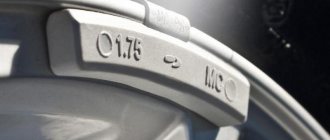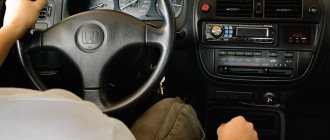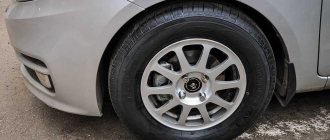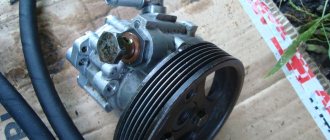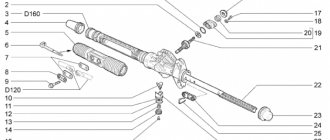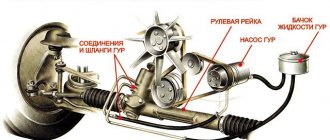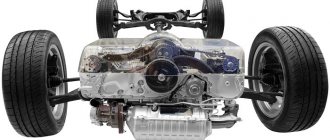Vibration of the steering wheel at speed is a clear sign of a certain defect in the car. Do not delay in diagnosing and eliminating identified faults in order to prevent serious consequences that could lead to an emergency. Reliable operation of the steering system ensures the absence of any “jitters” and “oscillations” transmitted to the driver’s hands when the vehicle is moving on a flat road with a high-quality surface.
Find out the cost of diagnosing the steering system online in 3 minutes
Don't waste your time - use the Uremont search and get offers from nearby services with specific prices!
Get prices
In what operating mode does the steering wheel shake or vibrate?
Depending on the mode in which the steering wheel vibrates or beats,
depends on the list of possible reasons
This is the first question you should ask if you want to find the cause of the steering wheel wobbling. Indeed, depending on the mode in which the shaking occurs, you can immediately eliminate impossible options and focus your attention on the more probable ones. For example, if it vibrates while standing in one place, then crooked or unbalanced wheels are definitely not at work. And so on.
When searching for the cause of vibration and beating of the steering wheel, it is advisable to divide all possible operating modes of the car into 7 groups:
- Parking with the engine running.
- Overclocking
- Driving in a straight line at speeds up to 50 km/h.
- Driving in a straight line at speeds above 90 km/h.
- Maneuvering.
- Braking.
- Driving on bad roads.
As a rule, if the steering wheel shakes only in one of the listed operating modes of the car, understanding the reason is as easy as shelling pears. It's a little more difficult if they overlap. That is, the defect actively manifests itself in two or three modes at once. However, you will have to sort through far fewer options than there are in total. Just for a second, there are 20 of them mentioned in this article alone.
Disc deformation
As already noted, they are far from ideal in their geometric characteristics. And how curved the wheels are greatly affects the behavior of the car. Wheel rims may become deformed due to the vehicle falling into a hole. Curvature can be detected visually. It is necessary to carefully inspect the rim for dents. But most often the inner part of the wheel rim is bent. Stamped products are most susceptible to deformation. Cast ones are destroyed to a lesser extent. The wheel rim may change its geometry during operation, or may be uneven initially. This is determined at a special stand. But there is a problem here - often on such equipment the wheel behaves correctly, but when driving a car it rotates unevenly. If the disk behaves this way, then it is clearly defective.
All possible causes of steering wheel beating and vibration
It is quite possible that for many it will be enough to go through a short list of all possible reasons to solve the problem. Therefore, first we list them without any explanation:
- Loose or worn motor mounts.
- Troubling or unbalanced engine.
- Insufficient idle speed.
- Worn steering rack drive shaft.
- Unbalanced wheels.
- Loose wheel nuts or bolts.
- Worn steering rack.
- Worn steering tips.
- Worn wheel bearings.
- Warped rims.
- Unadjusted wheel alignment.
- Bumps and hernias on rubber.
- Variation in tire pressure.
- Wear of constant velocity joints.
- Worn steering gear bearings.
- Loose steering column universal joint.
- Worn anti-roll bar bushings.
- Deformed parts of the brake mechanism.
- Uneven brake performance.
- Broken ball joints.
If this list is not enough to identify the reason why the steering wheel beats or vibrates in your case, the following points are described in more detail. In addition, they are considered in conjunction with the corresponding operating modes, which will allow us to immediately exclude most of our list.
Summary
If you study the malfunctions, you can derive a small rating of the prevalence of causes. So, if the steering wheel of a VAZ-2114 shakes at low speed, then in the first place are problems with the integrity of the tires and rims. For many, vibrations were caused by a hernia or a crooked wheel. Then there are breakdowns in the suspension and steering mechanism. But often the problem can be solved by a simple visit to a tire shop. And to eliminate this situation, you should brake well before each large hole and be careful when passing railway tracks. A bump on the sidewall of a tire cannot be restored.
Steering wheel vibrations in place
Finding the cause of steering wheel vibration while standing still costs four directions at once:
- Engine mounts.
- Troubling or unbalanced motor.
- Low idle.
- Steering rack drive shaft.
Let's look at each of them in a little more detail.
Engine mounts
Efficient engine mounts dampen vibrations
The power unit of a passenger car is attached to the frame or subframe on damping pads. They are needed so that during operation the vibrations of the motor are not transmitted to other parts of the machine. In particular, this applies not only to the steering, but also to the body as a whole. However, if these same pillows are worn out, or their fastenings are loosened, spreading shaking is inevitable.
Confirming or excluding this option is quite simple. To do this, you need to start the engine and look at its behavior under the hood. If the fastenings are really loose, then the vibrations will be visible, as they say, to the naked eye. They are most likely transmitted to the steering mechanism, and you feel them with your hands. Moreover, as a rule, this defect extends not only to the steering wheel, but also to the entire body. Accordingly, shaking can be observed in the form of rattling panels, plastic parts, and sometimes even side windows.
Despite the simplicity of this problem, fixing it is not always quick or inexpensive. If the dampers are still alive, but the fasteners have simply become loose, they can simply be tightened. However, this happens extremely rarely. More often, pillows become tanned or deformed, ceasing to perform their functions. In such cases, only replacing them will save you. This is not an easy event. But still, even without going to a service station, it’s doable.
Troubling or unbalanced motor
If the engine is tripping or unbalanced, no amount of “pillows” will save you
The engine begins to fail when one or more cylinders stop working stably or fail altogether. This often happens with gasoline engines due to the lack of a spark. In injection and diesel engines - due to clogged or worn injectors. In short, when fuel cannot either enter or ignite in one of the cylinders, the engine begins to stall.
The result is an imbalance. In a properly functioning engine, the pistons compensate each other's impulse during reciprocating movements. And when one of them begins to vibrate, vibrations begin. It is quite natural that they are transmitted to the steering and are felt tactilely. In addition, a throttled engine also pulls poorly, consumes more fuel, and can suddenly stall or, conversely, spontaneously gain speed.
In addition, a few words should be said about engine imbalance. The fact is that it can become a source of strong vibrations on the steering wheel not only when one or more cylinders fail. This can also be caused by wear of parts of the crank mechanism. In particular, broken seats for piston pins, liners on the crankshaft worn down to foil, and so on.
Low idle
Normal idle is 850-950 rpm.
If they are lower, then this is one of the reasons for vibration and beating of the steering wheel.
This reason is elementary if you just need to find out why there are vibrations in the steering wheel. Finding and fixing the problem is another matter. However, due to insufficient idle speed, the engine operates unstably and with vibrations noticeable throughout the body. Naturally, they are transmitted to the control mechanism, and as a result are felt by the driver.
It is very easy to confirm or, conversely, exclude this problem from our list. Especially if there is a tachometer on the instrument panel. Normal idle speeds for passenger car engines are from 800 to 900 rpm. If the needle on the tachometer periodically falls or constantly shows less than normal, vibrations are inevitable. Quite often, this problem appears periodically, or in conjunction with other factors. For example, when you turn on the headlights, heater or air conditioner.
Steering rack drive shaft
The drive shaft is at the very bottom - due to its wear, steering wheel beating is inevitable
The drive shaft transmits the rotation of the steering wheel to the rack using a simple mechanism, which, like everything else in the car, is subject to wear. When gaps and play appear between its parts, vibrations from the engine begin to be transmitted to the steering wheel. Unfortunately, determining or eliminating this option on your own is quite a difficult task for novice car owners. However, it is possible.
It is also worth noting that uniform vibration of the steering wheel while standing still may occur due to incorrect operation of the power steering. Owners of cars with electric amplifiers face a similar problem. It is not difficult to calculate these options if you systematically exclude all the others described above. In addition, due to incorrect operation of the power steering, vibrations, as a rule, are felt only when parked with the engine running, while when driving they disappear or become almost unnoticeable.
What are the consequences of ignoring the problem?
If you regularly hit the steering wheel while driving and you are even used to it, you should not think that the problem will not have consequences. Experienced car enthusiasts probably know that even the most wear-resistant mechanisms cannot tolerate frequent and strong vibration. It can damage almost any mechanism. It also does not have a positive effect on the driver. Please note that steering wheel vibration may increase over time. For example:
- For some reason, the steering wheel began to shake slightly. The problem is ignored;
- Tires wear out more. The beating becomes stronger;
- Bearings, suspension components, and individual elements of the steering mechanism wear out greatly. Driving a vehicle becomes much more difficult.
Experts are confident that the main problem with vibrations is the wheels, and in some cases, the brakes. The suspension of a car with a constantly vibrating steering wheel simply becomes weaker over time and its individual element may fail much earlier than expected. The danger here is that the driver of a problematic car becomes less attentive and more irritable, which, coupled with the technical shortcomings of the vehicle, can cause an accident.
Steering wheel vibrates when accelerating
For the steering wheel to vibrate only when accelerating the car, and in other modes the defect would disappear, this does not happen very often. However, you can give as many as five reasons why this is possible. These include:
- Unbalanced wheels.
- Loose or missing wheel bolts.
- Worn steering rack.
- Worn tie rod ends.
- Worn wheel bearings.
Let's look at each point in a little more detail.
Unbalanced wheels
Most often, due to unbalanced wheels, vibrations are felt on the steering wheel
when accelerating a car
This defect refers to those rare cases when vibrations on the steering wheel are felt only in one mode. In this case, this applies to vehicle acceleration. That is, if the problem manifests itself exclusively (or more intensely) during acceleration, and in other modes it subsides or disappears, first of all, attention should be paid to wheel balancing.
For those who do not yet know what this is, let us briefly consider this important point. Wheels whose weight is unevenly distributed around their circumference should be considered unbalanced. That is, on one side the wheel is heavier, and on the other it is lighter. At the same time, it doesn’t matter how much. Even a few unfortunate grams make a difference. They lead to an imbalance of the wheels, and centrifugal force comes into play, due to which vibrations are observed when the car accelerates.
If you suspect that this is your case, do not rush to go to the service station. Very often, wheel imbalance occurs due to contamination. Firstly, good, fresh tires may contain small pebbles unevenly. Secondly, dirt, snow and ice stick to the discs, especially on the inside. All this can greatly disrupt the weight balance of the wheels and, as a result, become the main cause of steering wheel vibration.
Are the wheels perfectly clean and there are no pebbles in the treads? The wheels may not have been balanced for a long time. This often happens when a car is purchased on the secondary market. In addition, owners of so-called all-season tires do not visit wheel balancing services for a long time. It lasts (with careful use, of course) for several years. And the wheels need to be re-balanced at least twice a year. Tires wear out, often unevenly, and rims become warped. As a result, the balance is disrupted much sooner than many people think.
Wheel bolts or nuts
Missing, incorrect, poorly tightened nuts and bolts -
can provoke not only vibrations, but also serious accidents
This reason is often found among novice car enthusiasts or inattentive experienced ones. The picture looks like this. The tire was punctured. Repaired at a service center or with your own hands. Then install and tighten the bolts or nuts while the car is on the jack. And when the latter is removed, no additional force tightening is performed. Did not know. Forgot. Someone or something distracted. As a result, the wheel remains unsecured as it should be...
Needless to say, this picture can end not only with vibrations on the steering wheel, but also with something much sadder. Despite the fact that the reason seems childish and naive, it is not so rare. There is plenty of evidence of this on the Internet. Many people have seen in their lives how a wheel leaves a car at full speed, additionally causing trouble for third parties. Unfortunately, the wheels and specialists at the service station are not up to par.
One good thing is that confirming or ruling out this possible cause of steering wheel vibration couldn't be easier. All you need is a standard key, which simply must be in the trunk of any car. The main thing is to have time to pay attention to this. Don’t be lazy and double-check the tightening torque of bolts or nuts with specialists. They are people too, which means they can forget and get distracted.
Steering rack
When the steering rack is worn, vibrations can be observed not only during acceleration
When the rack wears out, the steering wheel does not always vibrate only when the car accelerates. However, it is in this driving mode that this defect makes itself felt most often. It is very difficult to identify such a reason on your own, since on many cars even getting to the specified part is a real problem. However, do not forget about the elimination method. That is, when you discard all other possible options, suspicion on the steering rack will fall by itself.
Additionally, it would not be amiss to note that the repair or replacement of this steering part should not be postponed until better times or indefinitely. A broken steering rack can cause an accident or drag down other components of the control mechanism and chassis.
Steering tips
When the steering tips wear out, vibrations and beating of the steering wheel
present during acceleration, maneuvering and on bad roads
Wear of steering tips is one of the most common causes of steering wheel vibration when accelerating a car. It’s worth saying right away that they manifest themselves not only during acceleration. Loose tips lead to wobbling and wobbling when cornering and on bad roads. They also increase play in the steering wheel, which is immediately felt by the hands of an experienced driver.
In a nutshell, let's look at how to check steering tips for wear. Actually, without the help of a service station, this can be done in two ways:
- Rotation of the steering wheel. An assistant is needed for this check. One rotates the steering wheel in the cabin, and the second, being in the car (in an inspection hole, on an overpass or a lift), watches how the tips behave. Loose ones are immediately visible.
- This method does not require an assistant. To check the tie rod ends, you need to try to move the tie rods that connect them to the rack. In addition to the fact that this method allows you to see loose tips, during the inspection process, the rods themselves may also show their bad side.
If wear has been identified, then there are two options. The first is to replace the parts with new ones. This operation is not very complicated and can be easily performed even if you are a novice car enthusiast. The second option is to find specialists who restore tie rod ends. It will cost less. In addition, given the quality of spare parts sold today, remanufactured parts are likely to last longer than new ones.
Wheel bearings
This is what a broken wheel bearing looks like
Vibrations or, rather, wobbling of the steering wheel due to wear of the wheel bearings also more often occurs during acceleration of the car. The diagnosis is confirmed during maneuvering. When the life of the wheel bearings is exhausted, but not completely, the car begins to behave as if its wheels are made of jelly. Additional symptoms may include a humming, whistling, or grinding sound while driving.
How to check wheel bearings? To do this, you need to hang all the wheels on a jack one by one, shaking them with your hands at the same time. It is better to do the latter not from outside, but from below, being in the inspection hole. This way it will be possible to additionally check not only the bearings, but also the steering tips. As a rule, the former show their bad side if the wheel is shaken by grasping it from below or from above. The tips begin to dangle if you shake the wheel by holding it by the sides.
There is, in fact, only one way out of this situation. Wheel bearings that have exhausted their service life cannot be restored, tightened in any way, or anything else done. In this case - only replacement. Unfortunately, this procedure is not simple. You need certain tools and experience. However, it is possible to change the wheel bearings, as they say, with your own hands, even without a service station.
Radiator or air conditioner fan operation
A slight “shaking” of the steering wheel is possible when the electric radiator fan or air conditioner is turned on at full power. Unbalancing their mounting can cause an unpleasant effect. It is necessary to check the reliability of their installation. If the tightening becomes loose, fix the problem using a screwdriver. Clean the radiators from dirt and debris, this causes the fans to constantly operate at maximum mode.
To more accurately identify the causes of steering wheel vibration and have it professionally repaired, you should contact a specialized auto center. All you need to do is leave a request on the Uremont.com website, and our specialists will select the most suitable service option that meets your needs. Don’t put off problems with the steering system until later; early diagnosis of the problem will help you avoid large expenses on the purchase of expensive parts.
Driving at speeds up to 50 km/h
Among the twenty possible causes of vibration and beating of the steering wheel presented above, there are two that often appear only in this mode. Measured driving on a flat road at low or medium speed. These reasons include:
- Deformation of wheel rims.
- Unadjusted toe.
Both deserve special attention.
Deformed wheel rims
The wheel rim can be bent not only on the outside
To deal with steering wheel vibrations due to deformed discs, we have all the conditions. Namely, our beautiful roads, with knee-deep potholes. Also, discs often bend when driving unsuccessfully onto curbs, tree roots in the forest, and so on. Speed bumps that are overcome incorrectly can also bend any discs.
How to calculate this reason? The first thing you can do is visually inspect the wheels. Moreover, not only from the visible side, but also from the inside. You can also see uneven rims if you hang up all the wheels one by one and spin them by hand. Observing the rim during the process, noticeably deformed areas should be visible without any devices.
The solution to the problem is also quite simple. You can align the disks at the appropriate service. The service is called rolling. It is relatively inexpensive and, in principle, it is useful to perform it at least once a year. Especially if you live in a region where good roads are only shown on TV. It’s unlikely that you can do anything here with your own hands. Although there are those who have successfully leveled discs using a well-known percussion instrument. However, it is better not to do this.
Unadjusted wheel alignment
The situation is especially insidious when the wheels “look” in different directions.
Even the most novice car enthusiasts probably know about adjusting the camber and toe of wheels. This procedure should be done:
- after changing winter tires to summer tires and vice versa;
- once a year, if the tires are all-season and, accordingly, do not change for several years;
- after replacing wheel rims, for example, when stamped ones are replaced with cast or forged ones;
- after a run of 10,000 km;
- after any suspension or steering repairs.
All these points are interchangeable and self-sufficient, that is, they work on the principle that the first thing will come. Also, adjustments must be repeated if there is a feeling that they have gone astray. In some cases, this can be understood without special equipment. Firstly, the wheels “looking” in different directions can be seen if you look at the car from the front or rear. Secondly, incorrect alignment is felt on the steering wheel not only in the form of vibrations. He is also constantly pulled to the side on a completely flat road.
Out of balance due to mud or snow
One of the most likely reasons is that the disk is simply clogged with dirt or snow - in this case, the beating appears temporarily, it can stop literally immediately after gaining speed and does not appear again or after several minutes of driving. Determining the presence of dirt is easy in the case of alloy wheels and quite difficult in the case of steel wheels (which, as a rule, have rather small ventilation holes, and even decorative caps can interfere with visibility) - dirt is usually concentrated on the inside of the disk.
Steering wheel wobble at speeds over 90 km/h
We smoothly move on to the reasons that already smack of danger. Thus, steering wheel beating at speed and the reasons for its manifestation can result not only in discomfort, but also in a serious accident. Therefore, in such cases, the first thing to do is to stop using the car. And only then look for the reason among those discussed here.
Without excluding the options already discussed, pay attention to two more points:
- Cones.
- Variation in tire pressure.
Here, it seems, everything is clear. Therefore, literally in a nutshell on each point.
Cones
Cones are different -...
Bumps or hernias appear on tires due to the fact that the reinforcing frame inside the rubber, the cord, bursts. As a result, a tubercle appears on the weakened area, which grows over time under loads. First, this defect leads to wheel imbalance, which causes beating in the steering wheel. If such a tire is not replaced in a timely manner, sooner or later it will burst in this place. As a rule, this happens at a decent speed, when the tires experience the heaviest loads. Needless to say, it is absolutely impossible to drive a car on three wheels.
Tire pressure variation
Vibrations may be present at different pressures in wheels on the same axle
Despite the apparent simplicity of this reason, it occurs much more often than others. Many people do not properly monitor tire pressure. Over time, the spread increases, since almost always one tire goes flat faster than the others. In addition, the pressure in one of the tires may decrease significantly along the way when hitting a serious bump. Again, don’t forget about self-tapping screws, which appear in abundance on the roads from nowhere. When they get into the rubber, the tire may not deflate completely, but the pressure in it will certainly drop.
The result of all this is the same - beating in the steering wheel at high speed. The solution to the problem is also monotonous and simple. Firstly, when vibration appears, you need to stop immediately and find out the reason. Secondly, tire pressure must be monitored before each departure, as it should be, and not when a flat tire can be seen a kilometer away.
How can you solve the problem?
Some will take their favorite car to a service station. However, this should only be done when there is a reliable specialist who knows his job well. Otherwise, there is simply no guarantee that the source of vibration will be detected and the problem will be solved. Even in the event of such troubles (and they occur very often), repair specialists can charge a high price for the work. The driver may also pay for unnecessary operations. For example, a service station offers to replace the entire steering mechanism completely. Doing this is much easier than figuring out why the steering wheel shakes at low speed. The owner should be well aware of the reasons for this behavior - then he will not need the help of the service. You can almost always fix the problem yourself.
Vibration when turning
In cases where there is vibration when turning the steering wheel, you should start sinning by wearing out the following parts:
- CV joint if the car is front-wheel drive.
- Steering gear bearings.
- Steering column cardan.
- Anti-roll bar bushings.
Traditionally, we will walk through each point separately.
Worn CV joint
Constant velocity joints are connected through the wheels to the steering
(on a front-wheel drive car, of course)
Let us first emphasize that this reason only applies to cars with front-wheel drive. With significant wear of the constant velocity joints, steering wheel beating is observed during turns and other maneuvers, regardless of the speed limit. Identifying a defect is easy. To do this, you need to make a turn at minimum speed with the steering wheel fully turned. As a rule, if at least one CV joint has outlived its usefulness, in this mode it makes a nasty crunch.
This unit is usually not subject to repair. Replacement only.
Steering gear bearing wear
The bearings in the steering gear most often “die”
This unit serves to transmit and convert torque from the steering shaft to the rack. When the bearings in it wear out, a noticeable beating is observed on the steering wheel, which manifests itself especially sharply during maneuvering. By the way, it can also slip on potholes and potholes. These bearings suffer due to bad roads, or due to careless operation of the car. For some models, as car enthusiasts themselves note, this unit is a weak point, and therefore worries very often.
Worn steering column driveshaft
Due to the cardan, vibrations and beating in the steering wheel are more often felt on uneven surfaces.
This part is not present on all cars, but most still have it. The cardan is designed to transmit torque from the steering wheel to the gearbox or directly to the rack if the mechanism is without an amplifier. Mounted on bushings that tend to break or burst. Accordingly, there is a beating in the steering wheel, which is especially felt when cornering at relatively low speeds. On potholes and potholes you can also hear a characteristic crunching sound.
Wear of anti-roll bar bushings
Worn bushings lead to steering wheel vibrations during maneuvering
The anti-roll bar is designed to prevent the car from rolling during sharp maneuvers. In most cases, this part, the simplest in design, is mounted on four rubber bushings. When the resource of the latter is exhausted, a number of problems arise, including vibration when turning the steering wheel. On uneven road surfaces the effect is usually enhanced.
Vibration when idling or stationary: engine or drive shaft
There is another problem with car vibration - sometimes it happens that it arises due to loose engine mounts to the car body - in this case, vibration often appears even at idle in a stationary car, but it may well make itself felt only when starting to move, when you press on the accelerator pedal and thereby increase engine speed, resulting in resonance.
Such vibration can be distinguished quite easily - it is quite high-frequency and depends entirely on the number of engine revolutions - thus, if you increase the speed with the gas pedal, the vibration also becomes more frequent.
The drive shaft is also subject to inspection, but in very rare cases. This is the rapidly rotating power part of the engine drive to the rear axle of the wheels in rear-wheel drive vehicles. If it is bent for one reason or another, vibration may also occur. And in this case, the primary diagnosis is also simple: as the vehicle speed increases and, at the same time, the selected gearbox gear remains unchanged, the vibration will become more frequent.
Steering wheel wobble when braking
First, it is worth noting that when braking, steering wheel wobble can be observed for some of the reasons that were discussed above. However, there are two due to which unpleasant sensations appear only during braking:
- Deformation of brake discs.
- Uneven wear of brake pads or discs.
There’s not much to say about these points, so I’ll keep it short here.
Warped brake discs
Deformation and uneven wear are best viewed from this perspective.
Runout is observed due to the fact that when you press the brake pedal, the pads are pressed and slide over an uneven surface. Absolutely the same thing happens with deformed drums. The problem can be identified quite easily without specialists. To do this, you need to hang the wheels on a jack, remove them, and carefully inspect the brake system parts from all sides. As a rule, deformations sufficient to cause vibrations during braking are visible to the naked eye.
Uneven wear of brake discs
As in the previous case, the reason works in the same way. During braking, brake pads do not slide on the discs, but literally jump. Hence the wobble in the steering wheel. In addition, both defects manifest themselves in the form of vibrations not only on the steering wheel, but also on the brake pedal itself.
Balancing disorders
Tires and rims are not ideal either in terms of geometric characteristics or composition. And since the weight of these elements differs in some parts, then at the moment the wheel rotates, the point where the weight is greater will pull the center of the wheel towards itself. This is the effect of centrifugal force. Even at low speeds (and already at 40 km/h the wheels rotate quite quickly), vibrations will come to the steering wheel through the rods. Wheels must be balanced. This is done after replacing tires or wheels. The essence of the process is that the mass of the wheel is the same at each point. To do this, special weights are attached to the disk.
Bad road
Surely everyone already knows what bad roads are
In the end, it remains to consider the last possible reason for the steering wheel beating, which always manifests itself exclusively on bad roads. Again, in such conditions, other reasons described in this article are also possible. But they make themselves felt in other driving modes, while the remaining one is only on uneven surfaces.
Ball joints
Due to ball joints, beating and vibration in the steering wheel
transmitted during straight-line movement
The front wheels of the car are conventionally supported on ball joints and have the ability to turn. Structurally, it is an extremely simple detail. It wears out in the same place where it subsequently manifests itself in the form of vibrations on the steering wheel, namely on bad roads. Checking the ball joint is a little more difficult than the steering ends (they are all located nearby and are usually checked together), but, nevertheless, it is possible.
If wear is detected, there are two ways out of the situation. They are the same as with tie rod ends. The first option is replacement. The second is recovery. As a matter of fact, on some cars the ball joints are made in conjunction with the suspension arms, which makes replacing parts a rather expensive undertaking. For such cases, recovery was invented.
Dangerous vibration: loose wheel bolts/nuts
Another easily removable and no less easily diagnosed cause of steering wheel wobble and car vibration is simply loose bolts or nuts securing a wheel (or several wheels at once, which is less common). This reason for the beating is simple, but the most dangerous - if you do not detect the problem in time and the wheel completely flies away from the car, then this can end very disastrously both for you and for surrounding road users. However, repairs in this case can also turn out to be expensive if the cause of the vibration is not noticed in time - you will have to change the discs and, possibly, the brake disc or part of the hub, since the wheel will rub with enormous force against loose bolts or cotter pins, which will lead to severe deformation of these bolts or cotter pins, as well as the mounting holes in the disk.
The symptoms of vibration for this reason are similar to those as if the beating was due to deformed disks or tires, with the difference that it can begin at very low speeds - including at the very beginning of movement, and the vibration itself may not be with a clearly monitored cyclicity and is not always observed at the same speeds.
Just tighten all the bolts/nuts of your car's wheels to make sure that this is not the cause.
Brief summary
As a result, it turns out that in many cases the cause of steering wheel beating or vibration is quite possible to determine without the help of specialists. To make solving the problem easier, first try to find out exactly when the defect appears. Next, based on the information presented above, calculating the problem using the method of elimination is a matter of technology. Even if you are not going to fix anything yourself, it will still be useful to know about the source of vibrations. Firstly, you will quickly confuse the specialist at the service station, and secondly, you will not let him force you to repair parts that have not yet exhausted their service life.
Weak wheel fastening
This reason is very dangerous. If the wheel fastening becomes loose and the owner does not notice it in time, the wheel may fall off the hub while driving. The safety of the driver and passengers will be at risk. When the steering wheel shakes at low speed, the reasons are not sought here. But in vain. If this problem is not detected in time, then after a while the car enthusiast will come to replace discs, hubs, brake discs and much more. In this case, vibrations are noticeable even at very low speeds. The beats will be cyclical or acyclic. They can appear and disappear at the same speeds.
Useful tips
As mentioned above, steering wheel wobble cannot be ignored. The fact is that, regardless of the cause, vibrations and shocks gradually worsen the overall condition of the chassis and steering.
At the same time, vibration often appears even on a fully functional car. To avoid premature breakdowns, you need to choose the right wheels and tires, monitor their condition, maintain the brake system, etc.
As a rule, it is enough to regularly balance the wheels and do wheel alignment, clean the discs from dirt and ice, promptly change the brake pads and service the brake system, monitor the silent blocks, and replace them if necessary.
We also recommend reading the article about what a car brake caliper is, how a caliper works, and how to properly maintain brake calipers. From this article you will learn about the causes of caliper malfunctions and the main symptoms of problems, as well as when a brake caliper needs to be replaced.
It is also important to maintain the recommended tire pressure, as common mistakes lead to hernias and bumps, uneven wear, and damage to the discs. Also, at each scheduled maintenance, it is important to diagnose the chassis, check ball joints, wheel bearings, struts and other elements.
It would also be a good idea to check the steering mechanism and determine the steering play. In fact, play of more than 10 degrees is not allowed; any type of steering mechanism (for example, with power steering or power steering) must operate smoothly, without jamming or dips, with uniform force.
Tire pressure problems
Very banal reasons, but that doesn’t make them any less common. If vibration occurs at speed and the steering wheel feels beating when accelerating to approximately 100-120 kilometers per hour, it is worth checking the tire pressure.
It is extremely easy to check and fix this problem. For this you will need a regular pressure gauge.
Use a pressure gauge to check the current pressure. Compare it with those values that are the norm and recommended by the manufacturer of your machine. Typically for passenger cars this range is from 1.9 to 2.3 atmospheres. Having equalized the pressure, you need to drive the car again. If she stopped shaking, the reason was indeed low blood pressure.
